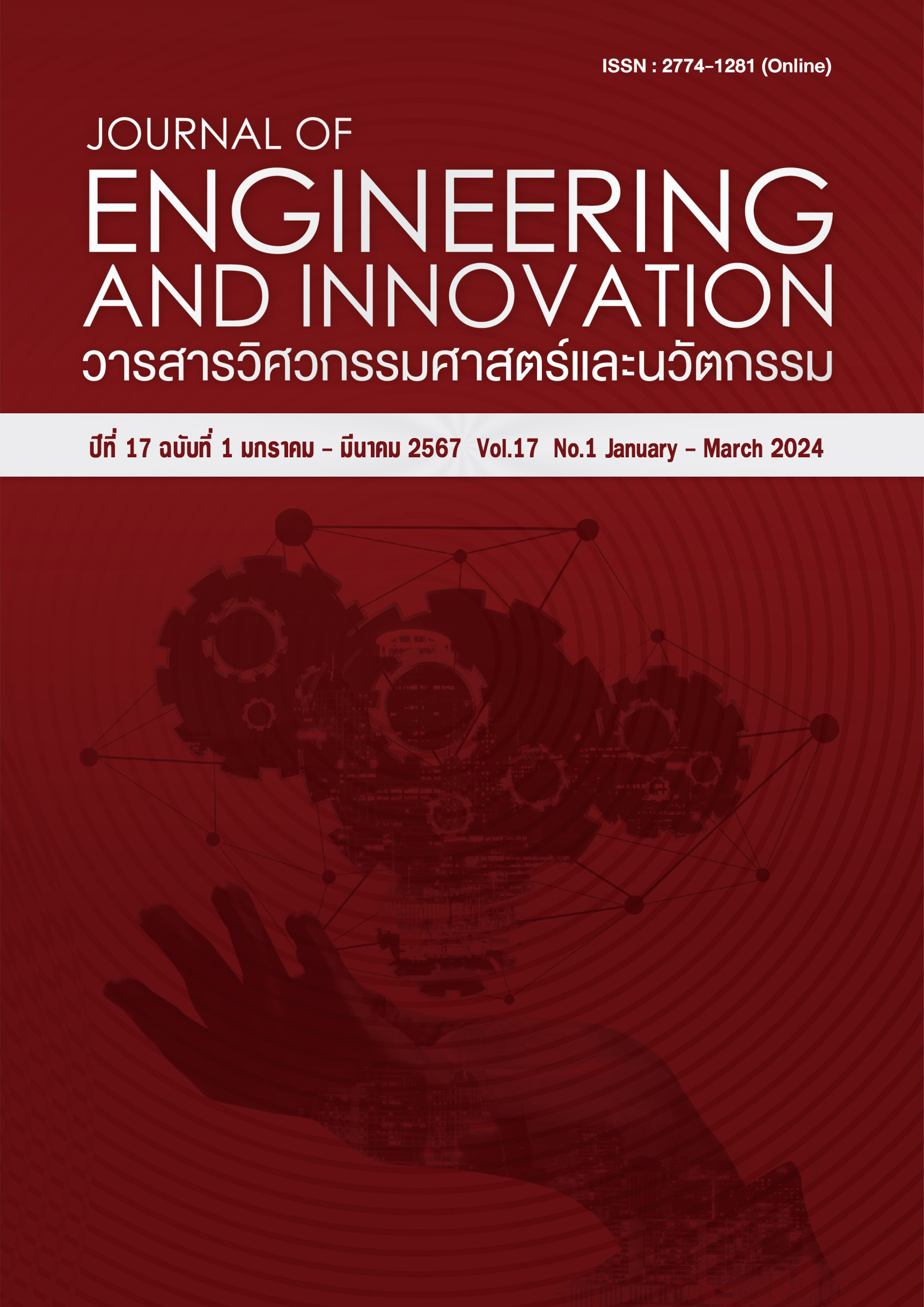An Inventory policy consideration based on break-even point under demand uncertainty and price sensitivity
Main Article Content
Abstract
This research aims to propose the inventory policy that considers the break-even point under uncertain demands and price sensitivity of a company's product case study, which sells both wholesale and retail products in order to increase business liquidity and profit opportunity. In this study, it developed a mathematical model suitable for policies of the Min-Max order and the conditional discount. Result from the study that the Min policy had a lower total inventory cost than other policies. While the Max policy and the conditional discount policy, the total inventory costs were different. According to the sensitivity analysis, it was found that the increasing or decreasing of products’ prices affected the selling price of products both retail and wholesale. Moreover, the conditions for trade discounts affect the level of money loss of each product differently. In the analysis of the break-even point, it was found that when the break-even point was 55% or more, Even though the purchase of goods had a trade discount or not. It will result in a net profit selling more retail than wholesale.
Article Details
References
Taleizadeh A.A., Tavassoli S. and Arijit Bhattacharya A. Inventory ordering policies for mixed sale of products under inspection policy, multiple prepayment, partial trade credit, payments linked to order quantity and full backordering. Annals of Operations Research. 2020; 287: 403–437. https://doi.org/10.1007/
s10479-019-03369-x
Hofstra N, Spiliotopoulou E, Leeuw S. Ordering decisions under supply uncertainty and inventory record inaccuracy: An experimental investigation. A Journal of The Decision Sciences Institute. 2022; 1-16. http://doi.org/10.1111/
deci.12564
Shah H. Nita. Ordering policies for inventory management when demand is stock dependent and a temporary price discount is linked to order quantity. REVISTA INVESTIGACIÓN OPERACIONAL. 2012; 33(3): 233-244.
Coniglio S, Koster A, Spiekermann N. Lot sizing with storage losses under demand uncertainty. Journal of Combinatorial Optimization. 2018; 36: 763-788. Doi.org/10.1007/s10878-017-0147-8.
Shah H. N, Patel G. D, Shah B. D. Optimal pricing and ordering policies for inventory system with two-level trade credits under price-sensitive trended demand. International Journal of Applied and Computational Mathematics. 2015; 1: 101-110.
Widyadana A. G. I, Wang K, Sutapa N. An optimal inventory model for a retailer with price dependent demand and unavailability supply. International Conference on Logistic and Business Innovation. 2020; 110-118.
Guo P, Jia Y, Gan J, Li X. Optimal pricing and ordering strategies with a flexible return strategy under uncertainty. Mathematics. 2021; 9(17), 2097: 1-12. Doi.org/10.3390/math9172097.
Bijari M, Shirneshan H. Stochastic lot-sizing: maximizing probability of meeting target profit. International Conference on Industrial Engineering and Operations Management. Istanbul, Turkey, July 3-6, 2012. p. 970-977.
วิสุทธิ์ สุพิทักษ์ และ มนตรี ฉัตรจินดากุล. นโยบาย เติมเต็มวัสดุคงคลังอะไหล่สำหรับการซ่อมบำรุงเชิงแก้ไขในหลายเครื่องจักรที่มีอัตราการเกิดชำรุดแตกต่างกัน. วารสารวิชาการพระจอมเกล้าพระนครเหนือ. 2564; 1-14. เข้าถึงได้จาก: Doi: 10.14416/j.kmutnb. 2021.07.003. [เข้าถึงเมื่อ 1 สิงหาคม 2565]
นิภาภรณ์ วาวจะโปะ, ปิยะวดี ประสงค์ศิลป์ และ วุฒิชัย ศรีโสดาพล. ตัวแบบสินค้าคงคลังร่วมกันระหว่างผู้ผลิตรายเดียวและผู้ซื้อรายเดียวโดยพิจารณาการลดช่วงเวลานำและการให้ราคาส่วนลด. KKU Engineering Journal. 2014; 41(1): 53-62.
อดิศัย วรรธระภูติ และ สรวิชญ์ เยาวสุวรรณไชย. แบบจำลองคณิตศาสตร์สำหรับกระบวนการสั่งซื้อธุรกิจนำเข้า. โครงการประชุมวิชาการเสนอผลงานวิจัยระดับบัณฑิตศึกษาแห่งชาติ ครั้งที่ 34, วันที่ 27 มีนาคม 2558 มหาวิทยาลัยขอนแก่น; 2558. 1466-1477. เข้าถึงได้จาก: https://gsbooks.gs.kku.ac.th/58/
the34th/pdf/HMO9.pdf [เข้าถึงเมื่อ 1 สิงหาคม 2565]
ณัฐพล สันแก้ว และ กาญจ์นภา อมรัชกุล. การกำหนดนโยบายบริหารสินค้าคงคลังแบบเติมเต็มร่วมกันหลายรายการ โดยมีข้อจำกัดการจัดส่งแบบเต็มคันรถ: กรณีศึกษา บริษัทจำหน่ายอุปกรณ์สำนักงานทาง E-Commerce แห่งหนึ่งในไทย. วารสารสถิติประยุกต์และเทคโนโลยีสารสนเทศ. 2562; 4(2): 18-30.
กนกพร ศรีปฐมสวัสดิ และ กุลวุฒิ โตรอด. การจัดการพัสดุคงคลังอะไหล่ในคลังสาขา. Pathumwan Academic Journal. 2020;10(27): 26 – 40.
Wali M. Application Optimizing the Placement of Safety Stocks Using the Max-Min Method for Printing Companies. International Journal of Research & Review. 2019;6(2): 203-210.
Zhu H. A simple heuristic policy for stochastic inventory systems with both minimum and maximum order quantity requirements. Annals of Operations Research. 2022; 309: 347–363.
Asana I M D P, et al., Inventory control using ABC and min-max analysis on retail management information system. IOP Conf. Series: Journal of Physics: Conf. Series. 2020; 1469(012097): 1-10. Doi:10.1088/1742-6596/
/1/012097
Romadhon I N, et al., Analysis inventory of consumable goods using min-max Method at Universitas Pertamina Journal of Emerging Supply Chain, Clean Energy, and Process Engineering. 2022; 1(1): 55-62.
นพพร ธนะชัยขันธ์. (2555). สถิติเบื้องต้นสำหรับ การวิจัย. วิทยพัฒน์ พิมพ์ครั้งที่ 3. กรุงเทพฯ. 241.
Shah H. N, Gor S. A, Jhaveri A. C, Optimal pricing and ordering policy for an integrated inventory model with quadratic demand when trade credit linked to order quantity. Journal of Modeling in Management. 2012; 7(2): 148-165.
Shah H. N, Patel G. D, Shah B. D. Optimal Inventory policies for Single-Supplier Single-Buyer Deteriorating Items with Price-Sensitive Stock-dependent Demand and Order Linked Trade Credit. International Journal of Inventory control and Management. 2013; 3(1-2): 285-301.
ช่อผกา โพธิ์ร่มไทร, ปวีณา เชาวลิตวงศ์. ระบบสนับสนุนการบริหารสินค้าคงคลังสำหรับธุรกิจขายสินค้าตกแต่งบ้าน. วารสารวิศวกรรมศาสตร์และนวัตกรรม.2565; 15(3): 36-45.
จีราดา อนุชิตนานนท์. การประยุกต์แบบจำลองโปรแกรมเชิงเส้นสำหรับการวางแผนการผลิต : กรณีศึกษาบริษัทผลิตชิ้นส่วนยานยนต์. วารสารวิศวกรรมศาสตร์และนวัตกรรม. 2565; 15(3): 46-56.

